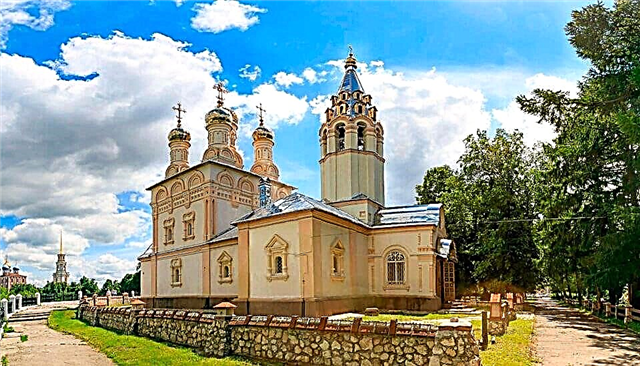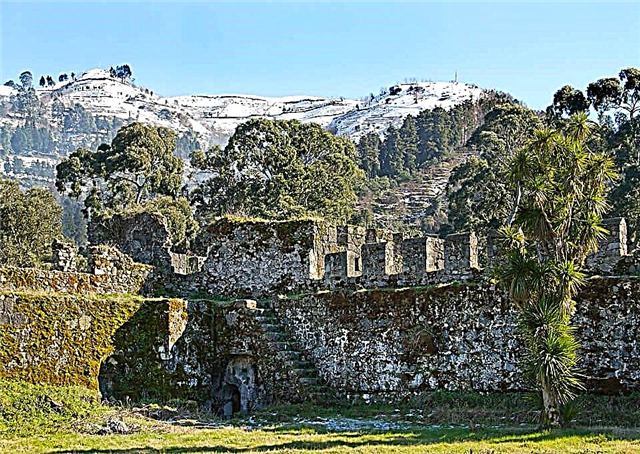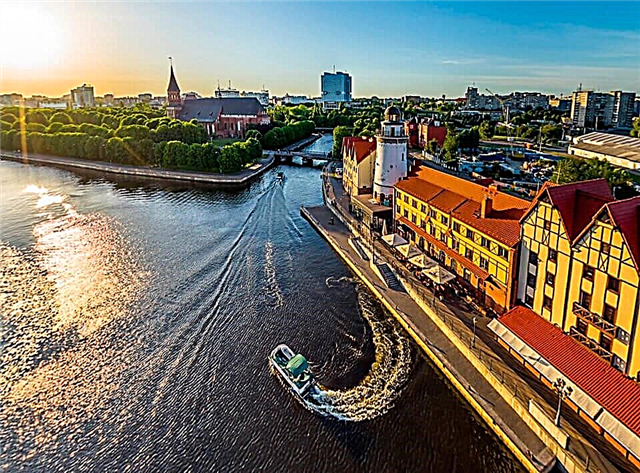Address: Russia, Yaroslavl region, Yaroslavl, Kotoroslnaya embankment, 2/1
Start of construction: 2004 year
Completion of construction: 2010 year
Recreated according to the project: A. M. Denisova
Height: 50 meters
Shrines: relics of the faithful princes Vasily and Constantine, the Yaroslavl icon of the Mother of God
Coordinates: 57 ° 37'21.1 "N 39 ° 54'07.8" E
Cultural heritage site of the Russian Federation
Content:
The Cathedral of the Assumption of the Blessed Virgin Mary, recreated on the site of an ancient temple, is a real decoration of an old Russian city. Today it has the status of a cathedral. The huge five-domed temple is visited not only by pilgrims, but also by many tourists. And although he does not copy the church blown up in 1937, the newly rebuilt church is a real monument of the traditions of Russian stone architecture, which began in the pre-Mongol period of the history of Russia.
History of the construction of the Assumption Cathedral
The construction of the very first stone building for the Orthodox Church in Yaroslavl began thanks to Konstantin, who was the eldest son of the famous Rostov prince Vsevolod the Big Nest. According to the traditions existing at that time, it was decided to dedicate the main cathedral to the Assumption of the Mother of God. Its construction began in 1215 and took four years. The temple rose in the middle of the wooden Kremlin - the prince's court on the picturesque Spit between Korotosl and the Volga and was consecrated by Bishop Kirill of Rostov.

View of the cathedral from the Volga embankment
We do not know for certain what that first church was, since the temple has not survived. The original appearance of this cathedral can only be understood on the basis of archaeological finds. According to the results of the excavations, it is known that the temple was built of red baked bricks - plinths. A peculiarity was that during the construction of the walls, a rather thick layer of mortar was used, often equal in thickness to the bricks themselves. Outside, the cathedral was decorated with white stone reliefs with carved masks and ornaments. The floor was covered with tiles made of majolica. And the doors leading to the cathedral were decorated with gilded copper. Its founder, Prince Constantine, was buried in this church.
The history of the temple in the XIII-XX centuries
When in 1237 the troops of Batu, who attacked Russia, burst into the streets of ancient Yaroslavl, almost the entire city was ruined. The cathedral of the Most Holy Theotokos did not escape a bitter fate. The invaders plundered this temple and deprived it of almost all the liturgical utensils, as well as the interior decoration.

View of the western facade of the cathedral
The next two and a half centuries became a time of peace and prosperity in the history of the Assumption Cathedral. But at the very beginning of the 16th century, there was a big fire, the vaults of the temple could not stand it and collapsed. When they were clearing the ashes, they found the relics of the Yaroslavl princes Konstantin and Vasily. The restoration of the burnt building took a long time - until 1516. Then it was possible to build only a low temple on the basement. From the west, it had a side-altar "on the beds", similar to the Moscow Annunciation Cathedral.
The next 17th century brought the Time of Troubles to Russia. And many Russian lands suffered greatly from the Polish-Lithuanian invasion. Yaroslavl did not escape the ruinous invasion. It is noteworthy that it was in this cathedral that the Rostov Metropolitan Kirill (Zavidov) gave his blessing to Prince Dmitry Mikhailovich Pozharsky for the liberation campaign of the Russian militia against Moscow.

View of the cathedral from the south
Then the heyday came for Yaroslavl. The city grew and developed. However, by that time the dilapidated cathedral became small for the townspeople. And it was decided to build a new large temple in its place. The tsar allowed the old cathedral to be dismantled, and its basement temporarily used as a "green and lead treasury" - a powder warehouse. But the room turned out to be too damp for storing gunpowder. Therefore, the local voivode ordered to finish building the walls that were not completely dismantled and to make a state chamber in the former cathedral.
A new temple was erected next to the old one from 1643 to 1646. It turned out to be one-story and had five chapters. However, in the 17th century, the Assumption Cathedral burned twice more during large fires, and each time it was restored anew. The rebuilt cathedrals changed in size and proportion, but they were always crowned with a massive five domes.
In parallel with the building of the temple, a high (55 m) hipped eight-sided bell tower was built, which existed until 1836, when it was replaced with a new one - a multi-tiered one. The author of the project was the famous architect and rector of the Imperial Academy of Arts Abraham Ivanovich Melnikov.

In the new bell tower, one could guess various architectural techniques, united by the style of the so-called romantic eclecticism. Melnikov's unusual decision was to install the octagon on the second tier on the quadruple of the first, and place the quad again on the third tier. Indeed, in the architecture of the 19th century, it was no longer accepted to use octals. An arch for the passage was made under the new bell tower.
In addition, in the 30s of the XIX century, a warm temple was added to the cathedral from the south, consecrated in honor of the Yaroslavl noble princes Constantine and Vasily. The need for such alterations arose due to the tightness. The Dormition Cathedral was considered the main one in the diocese by its status. And the small warm Vladimirsky side-chapel that existed before could not accommodate everyone who came to church services. Construction work on the reconstruction of the cathedral at that time was headed by Archbishop Abraham (Shumilin).

The eternal flame against the background of the Assumption Cathedral. View of the cathedral from Chelyuskintsev square
In 1844, church domes were the first in the city to be gilded, and they sparkled in the sun. According to documents that have survived from the 19th century, it is known that inside the cathedral there was a beautiful five-tiered iconostasis, on which valuable ancient icons were installed.
In 1918, a White Guard uprising took place in Yaroslavl against the rule of the Bolsheviks. The walls of the Assumption Church were damaged during the shelling, but the parish community found funds and the building was repaired. Several years later, a campaign was launched to seize valuable church property. Sad times have come for the Cathedral of the Dormition of the Most Holy Theotokos. The most valuable items from the temple sacristy had to be transferred to the state. During these years, the cathedral housed the city labor exchange.
Then came the times of a total struggle between the state and religion. In 1929, the bell tower was dismantled, and a little later, the church community was dissolved, at least somehow maintaining the cathedral in good condition.

Sculpture of the Holy Trinity against the background of the Assumption Cathedral
In the deserted church, premises were equipped for a sewing workshop, as well as for a warehouse where art values were kept for sale abroad. Then a granary was located in the cathedral for seven years.
On August 26, 1937, the shrine of the Yaroslavl lands was completely lost. The ancient temple, which had stood for several hundred years, was blown up. Then the stone rubble was cleared and a park of culture and recreation was set up on the territory. And the lost cathedral remained only in photographs taken in 1911 by the famous Russian photographer Sergei Mikhailovich Prokudin-Gorsky.
Later, the famous Soviet archaeologist Nikolai Nikolayevich Voronin and other specialists repeatedly tried to find the remains of the foundation of the first pre-Mongol cathedral. But these attempts did not bring positive results.

View of the cathedral from the side of the arrow
Reconstruction of the Assumption Cathedral
The fundamental decision to build a new temple was made in 2004, after large-scale archaeological work. A year later, in a solemn atmosphere, the foundation stone was consecrated. Moscow builders erected the temple from 2004 to 2010, using an architectural project developed by Alexei Denisov.
The consecration of the revived cathedral was timed to coincide with the celebration of the 1000th anniversary of the city. It took place in the fall of 2010. At the same time, the relics of the Yaroslavl princes revered by the faithful were returned to the temple, as well as a copy from the Yaroslavl icon of the Mother of God. Three years later, exploration work began to restore the lost temple bell tower. It is planned to build it with a height of 70 m. In the meantime, the bells for the future belfry were placed next to the building of the cathedral.

Stone to the founders of the city against the background of the cathedral
The new temple accommodates simultaneously up to 4 thousand believers and reaches a height of 50 m. Its total area is about 2 thousand square meters. m. There is a sculpture dedicated to the Holy Trinity near the building. A mosaic icon of the Assumption of the Blessed Virgin Mary is placed above the entrance to the cathedral. The walls of the building are decorated with tiles. It is very spacious inside, and, despite the "novelty", there are many old icon-painting images. This golden-domed temple looks especially good from the city embankment, from the Volga.
The current state of the Assumption Cathedral and the visiting regime
The cathedral is a functioning Orthodox church. Daily church services are held there at 8.00 and 17.00. Services start at 8.40 on Sundays and public holidays. The feast day is celebrated in the cathedral on 28 August. The relics of the faithful princes Basil and Constantine are considered to be temple relics revered by believers.

Cathedral domes
How to get to the Assumption Cathedral
The cathedral is located in Yaroslavl on Korotoslnaya embankment, 2/1.
By car. The federal highway M8 leads from Moscow to Yaroslavl. Within the city limits, it is called Moskovsky Prospekt. On it, you need to cross the Korotosl River across the bridge, and then turn right onto the Korotoslnaya embankment, which will lead to the cathedral.
By train. From Moscow to Yaroslavl, express train trains reach in 3 hours 16 minutes. The journey by regular train takes from 4 to 5.5 hours. From Moskovsky Train Station in Yaroslavl, the distance to the Assumption Cathedral is 3.5 km. They can be walked or taken by taxi.











